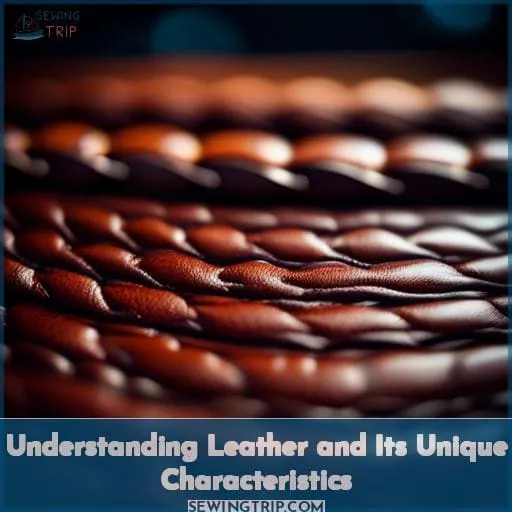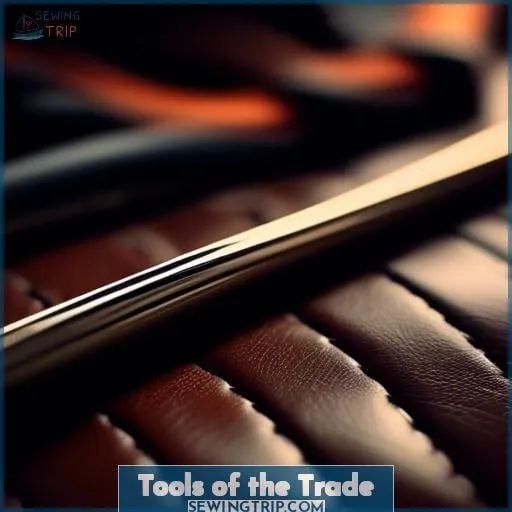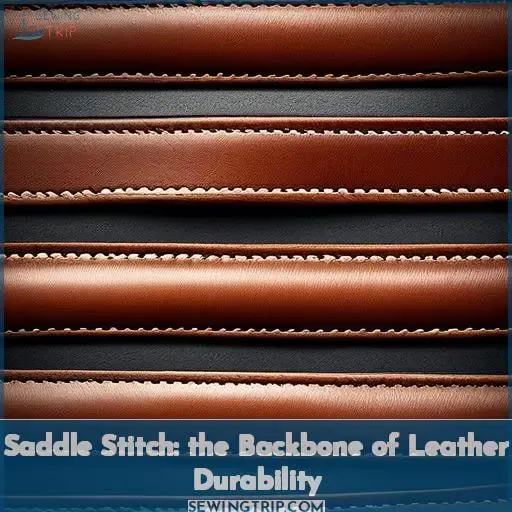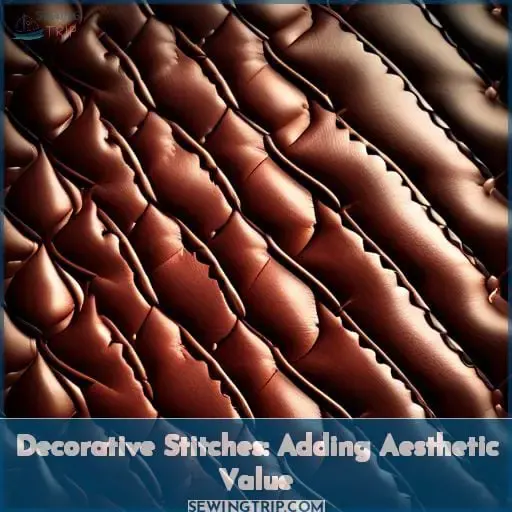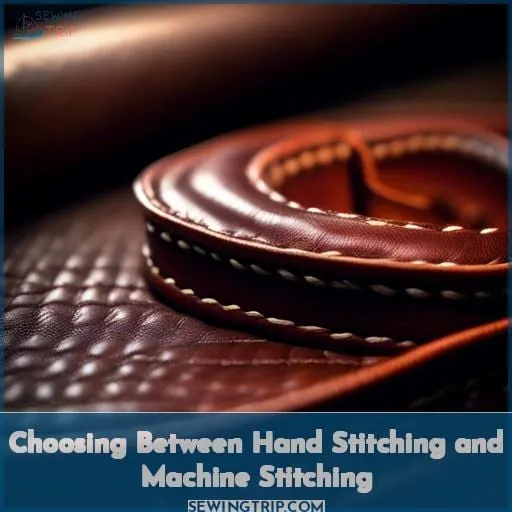This site is supported by our readers. We may earn a commission, at no cost to you, if you purchase through links.
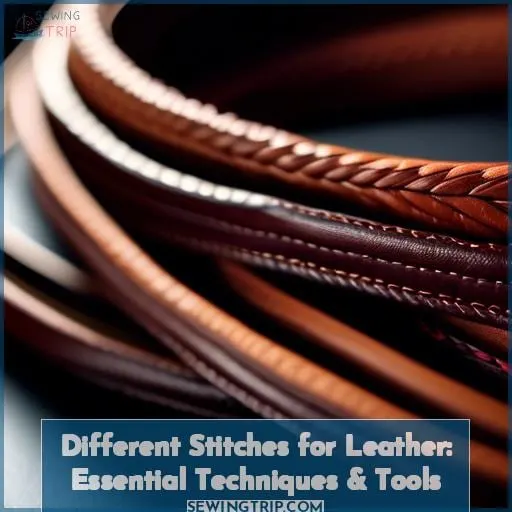 Imagine threading a needle through the resilient hide of leather, each stitch a testament to both strength and beauty. You’re not just crafting an item; you’re weaving durability and design into every seam.
Imagine threading a needle through the resilient hide of leather, each stitch a testament to both strength and beauty. You’re not just crafting an item; you’re weaving durability and design into every seam.
In the world of leatherwork, different stitches serve not just a functional purpose but also an artistic one. Whether you’re hand-stitching a rugged saddle stitch or adding flair with a decorative cross stitch, the right technique can elevate your leather project from mere accessory to a masterpiece of craftsmanship.
Dive into the essential techniques and tools for different stitches for leather, and embrace the blend of practical experience, technical knowledge, and artistic appreciation.
Table Of Contents
Key Takeaways
- Leather’s thickness and toughness necessitate specific stitching techniques to enhance both durability and aesthetic appeal.
- The saddle stitch is highly preferred for items subjected to wear and tear due to its unmatched strength and longevity, making it a cornerstone of leather durability.
- Tools such as awls, strong threads, blunt-tipped needles, stitching ponies, and clamps are essential in the leather stitching process, facilitating smoother and more precise work.
- The choice of stitch, including saddle stitch, cross stitch, and others, depends on the leather type and the intended use of the item, with considerations for both aesthetic appeal and durability.
Understanding Leather and Its Unique Characteristics
When you’re working with leather, you’re engaging with a material that’s both robust and refined. Its thickness and toughness demand specific stitching techniques to ensure durability.
The right stitch can elevate the aesthetic appeal of your final product. You’ll find that choosing the appropriate stitch not only enhances the item’s longevity but also contributes to its unique charm.
Leather’s Thickness and Toughness Require Specific Stitching Techniques
Leather’s not your average fabric; it’s like the Hercules of materials, demanding its own set of tools and techniques to tame it.
- Leather strength isn’t just for show; it means you’ll need needles that won’t throw in the towel halfway through.
- Thread durability is key. Imagine using a thread that gives up the ghost sooner than your enthusiasm does.
- Stitch tension and patterns need to be just right. Too loose, and your project might fall apart at the seams—literally.
So, grab your tools, and let’s stitch up a storm. Remember, it’s not just about making do; it’s about making darn good.
Importance of Choosing the Right Stitch for Durability and Aesthetic Appeal
Choosing the right stitch for your leather project isn’t just about holding pieces together; it’s about marrying form and function in a dance of durability and design.
Imagine you’re a maestro, selecting the perfect thread thickness and stitch patterns to complement the types of leather you’re working with.
Whether you’re crafting a rugged saddle that’ll weather the storms or a sleek wallet where edge finishing is king, the devil’s in the details—like ensuring hole spacing is just right to avoid a tearful tragedy.
So, pick your stitches wisely, because in the world of leather, every stitch counts!
Tools of the Trade
To embark on the journey of leather stitching, you’ll need to arm yourself with the right tools. Awls, strong threads, and needles are the backbone of any leathercraft project, ensuring your stitches are precise and durable.
Stitching ponies and clamps become your steadfast allies, holding your work securely and freeing your hands to create those perfect stitches.
Essential Tools for Leather Stitching: Awls, Strong Threads, and Needles
As you’ve learned about leather’s unique characteristics, you’ll appreciate that stitching it’s no small feat.
- Awls: Your best friend for punching through stubborn leather.
- Strong Threads: Waxed linen or polyester to withstand the pull and pressure.
- Needles: Blunt-tipped and sturdy, they’ll follow the awl’s lead without a fuss.
- Stitching Ponies: Like a second pair of hands, they hold your project steady.
- Clamps: To grip the leather without leaving a mark, because nobody likes a bully.
The Role of Stitching Ponies and Clamps in Facilitating the Stitching Process
Stitching ponies and clamps aren’t just tools; they’re your silent partners in the art of leathercraft. Imagine trying to juggle your leather piece, needle, and thread all at once. It’s like trying to pat your head and rub your belly simultaneously – possible, but why make life harder? Enter the stitching pony and clamp, offering a third hand when you’re in the thick of it.
Their design isn’t just about holding pieces together; it’s about making your stitching journey smoother than a well-oiled saddle.
Here’s a quick breakdown of how these tools elevate your craft:
| Feature | Benefit |
|---|---|
| Clamp Design | Ensures your leather doesn’t dance away as you stitch. |
| Pony Stability | Like a rock, it holds firm, letting you focus on precision. |
| Clamping Techniques | Offers flexibility, adapting to the shape and size of your project. |
| Pony Ergonomics | Designed for comfort, because your hands deserve a break. |
| Tool Compatibility | Works with a variety of leather types and thicknesses, no fuss. |
With these allies by your side, you’re not just stitching; you’re orchestrating a symphony of durability and beauty. So, let’s raise a needle to these unsung heroes of leathercraft, ensuring every stitch is a testament to your skill and their steadfast support.
Saddle Stitch: the Backbone of Leather Durability
When you’re crafting leather goods that need to withstand the test of time, the saddle stitch is your go-to technique.
It’s a method that combines practical experience, technical knowledge, and an appreciation for the art of leatherwork.
This stitch is preferred for items subjected to wear and tear because of its unmatched strength and longevity, ensuring your creations not only look beautiful but last longer too.
A Detailed Look at the Saddle Stitch Technique for Strength and Longevity
After mastering the essential tools, you’re ready to dive into the heart of leather durability: the saddle stitch. This age-old technique isn’t just a stitch; it’s a testament to craftsmanship, marrying strength with elegance.
- Thread Thickness & Needle Sharpness: The right combo ensures your stitches aren’t just strong but also sleek. Thick thread and sharp needles make for a robust seam that’s also a feast for the eyes.
- Hole Placement & Stitch Spacing: Precision here means durability. Evenly spaced stitches, made through accurately placed holes, distribute tension evenly, making your leather piece not just survive but thrive.
- Leather Type Consideration: Not all leather is created equal. Matching the saddle stitch technique to the leather type ensures that your project doesn’t just look good on day one but ages gracefully.
Embrace the saddle stitch, and you’re not just crafting; you’re creating heirlooms.
Why Saddle Stitch is Preferred for Items Subjected to Wear and Tear
Saddle stitch isn’t just a technique; it’s the secret sauce for leather items that need to laugh in the face of wear and tear.
Imagine two threads dancing in a figure-eight, each step reinforcing the other. If one thread decides to take a break (aka breaks), the other keeps the show going, ensuring your beloved leather piece doesn’t come apart at the seams.
This stitch is the Hercules of leatherwork, flexing its muscles at stress points and ensuring your item isn’t just a fleeting fashion statement but a long-term companion. It’s like having a bodyguard for your wallet or bag, ready to withstand whatever life throws its way.
So, when you choose a saddle-stitched item, you’re not just buying a product; you’re investing in longevity.
Decorative Stitches: Adding Aesthetic Value
When you’re looking to elevate the visual appeal of your leather creations, incorporating decorative stitches like the cross stitch and baseball stitch can make all the difference.
These stitches not only add a layer of sophistication but also enhance the overall aesthetic of leather items, making them stand out.
By mastering these techniques, you’ll be able to infuse your projects with a unique charm that’s both visually striking and intricately detailed.
Cross Stitch and Baseball Stitch for Decorative Purposes
After mastering the saddle stitch for durability, let’s dive into the world of decorative stitches that add that extra flair to your leather projects.
Cross stitch and baseball stitch patterns aren’t just about holding pieces together; they’re about turning your work into a canvas for artistic needlework. Imagine the cross stitch as painting with thread, each stitch a brushstroke adding depth and texture.
The baseball stitch, on the other hand, is like the bold lines in a drawing, giving structure and a playful edge reminiscent of its namesake. These stitches are more than just functional; they’re your ticket to creating leather embellishments that tell a story, adding intricate details that catch the eye and spark conversations.
So, grab your needle and thread, and let’s stitch some personality into your leather creations!
How These Stitches Contribute to the Visual Appeal of Leather Items
Cross stitch and baseball stitch aren’t just your run-of-the-mill stitches; they’re the secret sauce that transforms a plain leather piece into a masterpiece.
Imagine the cross stitch weaving its magic, creating patterns that dance across the leather, while the baseball stitch adds that home-run appeal with its distinctive, looping elegance.
These stitches are more than just threads through leather; they’re a conversation between art and functionality. With every stitch pattern design, there’s a story being told, a personality being woven into the leather.
The choice of color combinations and thread texture plays a pivotal role here, turning a simple wallet or bag into a statement piece that screams, Look at me!
It’s this blend of embellishment techniques, functional and decorative stitching, that elevates a leather item from good to unforgettable. So, when you pick up that leather piece, remember, it’s not just stitched; it’s stitched with intention, with a dash of flair and a sprinkle of creativity.
Choosing Between Hand Stitching and Machine Stitching
When you’re deciding whether to hand stitch or machine stitch leather, consider the unique benefits of each method.
Hand stitching offers unmatched durability and a personal touch, making each piece a testament to craftsmanship and care. On the flip side, machine stitching can be appropriate for larger orders or when efficiency is key, though it may not match the strength and character of hand-sewn leather.
Keep in mind that while machine stitches are consistent, they lack the repairability and artisanal quality of hand stitches.
The Advantages of Hand Stitching: Durability and Personal Touch
Hand stitching leather isn’t just about durability; it’s an art form that adds a personal touch to your creations.
Each stitch is a testament to authenticity, a narrative of craftsmanship that machine stitching can’t replicate.
You’re not just buying a product; you’re inheriting an heirloom quality piece, brimming with personalized designs and a unique aesthetic.
The tactile satisfaction of a hand-stitched item is like a handshake from the artisan themselves, a silent nod to the meticulous effort poured into every seam.
Embrace the charm of imperfections that tell a story, a narrative woven into every fiber, making your leather piece truly one of a kind.
Situations Where Machine Stitching Might Be Appropriate and Its Limitations
While hand stitching leather adds a personal touch, there are times when machine stitching takes the reins. Imagine you’re in the throes of large-scale production; efficiency is your bread and butter.
- Industrial applications: When you’re crafting a mountain of goods, automation is your trusty steed.
- Large-scale production: Like a well-oiled assembly line, machine stitching keeps the gears of commerce turning.
- Time efficiency: It’s a race against the clock, and machine stitching is your sprinter.
- Stitch precision: Each stitch is a carbon copy of the last, a testament to the machine’s unwavering consistency.
- Automation: Let the robots toil, while you oversee the symphony of synchronized needles.
But remember, with machine stitching, you might sacrifice the soulful artistry of handcrafted leather.
Frequently Asked Questions (FAQs)
How can I prevent my hand-stitched leather from looking dirty or discolored over time, especially when using prewaxed linen thread?
To keep your hand-stitched leather pristine, especially with prewaxed linen thread, it’s all about the prep and care.
Before you start, ensure your hands are as clean as a whistle. Regularly waxing the thread not only makes stitching smoother than a hot knife through butter but also acts as a barrier against grime.
If your masterpiece starts looking like it’s been through the wringer, a gentle cleaning with a soft brush or cloth can work wonders.
What are the best needle options for someone with arthritis or tendonitis who finds it difficult to use thick harness needles for leather stitching?
Navigating the world of leather stitching with arthritis or tendonitis can feel like trying to thread a needle in a storm.
But fear not, as there’s a beacon of hope. Opt for ergonomic needles or those with larger, padded handles to ease the grip.
Birch or bamboo needles are your allies here, being lightweight and kinder to touch, making each stitch less of a Herculean effort and more of a gentle glide through butter.
These options not only reduce the strain on your joints but also bring back the joy and artistry in your leatherwork, turning each project into a masterpiece without the pain.
Can you recommend affordable sources for high-quality linen thread suitable for leather stitching?
For top-notch linen thread that won’t break the bank, check out FANDOL on Amazon. They’ve got a 100% natural, waxed linen thread that’s perfect for leather stitching.
It’s a steal at $98 for 804 feet. Happy stitching!
How do I choose the right thread size for different leather projects, from small items to larger ones, to ensure the stitching looks appropriate and durable?
While you might think thicker thread always equals more durability, it’s about balance.
Match thread size to leather thickness using the rule of thumb: divide leather thickness (mm) by 7 for ideal thread size.
What are the pros and cons of using decorative machine stitches on leather, and how do they compare to hand-stitched aesthetics and durability?
Machine stitches on leather are quick and efficient, but lack the strength and character of hand-stitching.
They’re great for a snazzy look but don’t expect the same rugged charm or longevity as the handcrafted saddle stitch.
Conclusion
As the sun sets on our journey through the art of leatherwork, remember that mastering different stitches for leather is akin to holding history in your hands.
With the right tools and techniques, you’ll not only ensure durability but also infuse each piece with a touch of your soul.
Whether you’re hand-stitching with precision or opting for the efficiency of a machine, your work reflects a blend of strength, beauty, and personal flair.
Embrace this craft, and let your creations tell their own stories.

